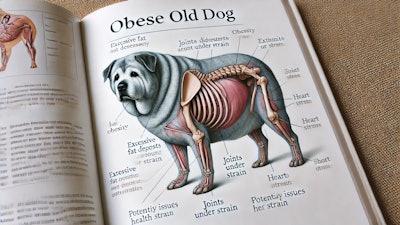
Humanization of pets included the humanization of pet illness. As with people in many regions, obesity-related health problems outweigh the dangers of malnutrition and starvation for dogs and cats. Despite pet obesity’s prevalence, veterinarians continue to face challenges in communicating the dangers of pet obesity. Talking to people about the reduction in pets’ lifespans associated with obesity may be particularly influential. In a survey of 1,108 dog owners, life expectancy ranked as the most important aspect of obesity-related communications with veterinarians (relative importance, 28.56%), while the change in price was less relevant.
“By integrating the information clients value into these discussions and emphasizing the positive impact of reaching or maintaining an ideal body weight on life span, veterinary professionals may more effectively support clients in taking action to prevent or address their pet being overweight,” the researchers wrote in the Journal of the American Veterinary Medical Association.
The second more important information in obesity-related communications was the timeline for developing arthritis (19.24%). The study authors referred to earlier research documenting that the most crucial aspect of effective osteoarthritis management and prevention lies in achieving and sustaining a lean body condition through appropriate nutrition and feeding practices.
“This lifelong study investigating diet restriction and aging in dogs revealed that maintaining an ideal body condition score through restricted diets significantly delayed the onset of late-life diseases, particularly osteoarthritis,” they wrote. “Veterinary professionals can leverage these findings in both their preventive weight conversations and obesity-related conversations with clients, emphasizing the direct link between weight management and joint health. By doing so, veterinary professionals may have the opportunity to proactively improve the overall well-being and mitigate the risks of obesity-related conditions for dogs.”
Just surviving isn’t enough. A dog’s future quality of life was the third most relevant topic in veterinary communications about obesity (18.91%). Quality of life can be hard to define, and the researchers suggested that this ambiguity was related to its lower importance to dog owners.
Cost of weight-related dog food
Following closely behind quality of life was the change in the cost of food (18.90%).
“Within the change to the cost of food attribute, participants preferred diet recommendations with a cost increase of CAD0.19/d compared to baseline, followed by a preference for no change in price,” they wrote. “These results suggested that participating dog owners may not have considered cost the most important factor when deciding whether to address their pet's weight and that they are open to at least a certain amount of cost increase in addressing the weight of their pet. It is also possible that the cost-per-day presentation is not typical of how owners think of the cost of feeding their pet, in contrast to the total up-front cost for a single purchase of a diet. Preferences identified by DCE studies are not intended to be interpreted outside the context of the attributes and levels used in an individual study. Therefore, further research is needed that explores the role of a pet owner's willingness to pay in taking action to address their pet's overweight or obese condition. Specifically, future research on pet owners’ cost tolerance should include examining their willingness to pay within the context of the pet owner's understanding of the potential benefits gained from weight management for their pet.”
Pet food industry professionals may adapt these insights into their consumer education, focusing on the impact of obesity on life expectancy, arthritis prevention, and the overall benefits of maintaining an ideal body weight. Tailoring communication to address these pet owner priorities may ultimately enhance the health and longevity of companion animals.



















